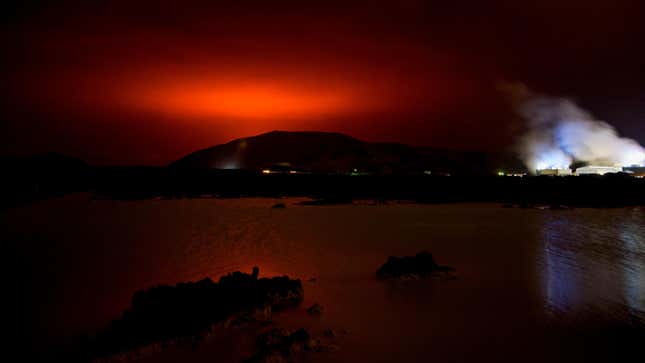
A long-dormant volcano erupted on Iceland’s Reykjanes Peninsula on Friday, shooting a fountain of lava that lit the night sky roughly 19 miles (30 kilometers) southwest of the nation’s capital, the Icelandic Meteorological Office reported Friday. The eruption, estimated to be the peninsula’s first in almost 800 years, follows weeks of increased seismic activity in the region.
“The eruption is considered small at this stage and the eruptive fissure is app. 500 m [546 yards] long. The magma area is app. 1km2. [0.4 square miles],” the IMO said in a tweet. “Lava fountains are small.”
The agency later tweeted a video of the eruption’s aftermath taken from a Coast Guard helicopter, which you can check out in all its terrifying glory below.
The eruption occurred near the Fagradalsfjall mountain and began around 4:45 p.m. ET on Friday, blasting lava up to 109 yards (100 meters) into the air, Bjarki Friis of Iceland’s meteorological office told Reuters. The IMO first spotted the eruption with a webcam it installed close to the mountain, which it then confirmed via thermal satellite imagery. Hours later, the agency said the lava appeared to be flowing “slowly to the southwest and west.” The glow of the lava could be seen from the outskirts of Iceland’s capital city, Reykjavík.
While local authorities said they didn’t believe the eruption poses an immediate threat to nearby towns, they advised residents to close their windows and stay indoors to avoid potentially inhaling volcanic gas ejected from the fissure. The Icelandic police also urged people to stay away from the eruption site for the time being as first responders continue to assess the situation.
More than 40,000 earthquakes have hit the region in the past four weeks, Reuters reports. The peninsula saw roughly 400 earthquakes on Thursday morning alone, and several low-frequency earthquakes were recorded below Fagradalsfjall earlier in the day on Friday, according to the IMO.
Iceland is one of the most volcanic nations in the world. Of its approximately 130 volcanoes, roughly 30 remain active. The Reykjanes Peninsula has remained relatively calm after sputtering on and off in a series of major eruptions between the 10th and 13th centuries, but scientists began bracing for potential eruptions after the region’s rate of earthquakes sharply increased in 2019.